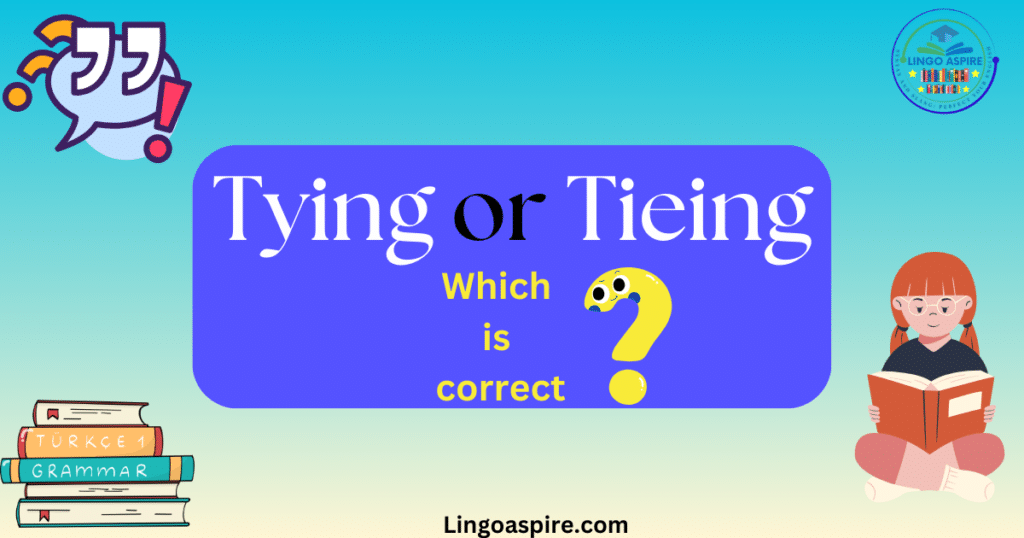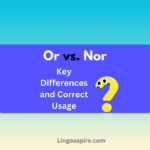In English, spelling mistakes can often cause confusion, especially when words appear similar but follow different rules. One such case is the ongoing confusion between “tying” and “tieing.” Though the words might seem interchangeable, they aren’t. For those unsure about the correct form, understanding the rules behind each spelling and how to use them properly can be quite beneficial. This article explores the differences between “tying” and “tieing,” how to correctly use the term in sentences, and why spelling matters.
Whether you’re writing professionally, sending a casual email, or just expressing an idea, knowing the proper spelling is crucial. This post will break down the confusion, explain grammar rules, and guide you on how to use “tying” accurately. By the end, you’ll understand the significance of correct spelling and how it enhances clarity and effectiveness in communication.
What Does “Tying” Mean?
At its core, “tying” refers to the act of fastening, securing, or binding something together using a knot, string, rope, or similar means. It’s an essential word in many everyday activities, from tying your shoes to tying a knot to hold something in place. However, the meaning of tying isn’t limited to physical acts—it can also be applied in a more abstract sense, such as tying connections between people or ideas. For example, you might say, “The bond they share is tied by mutual respect.”
The action of tying something is commonly associated with physically securing objects together. For instance, a person tying a boat to a dock ensures that it doesn’t float away. Similarly, you could say, “She spent the afternoon tying ribbons on gifts.” Tying can also be used in figurative contexts, such as tying a team together with a common goal or tying up loose ends before finishing a project.
Understanding what tying means is key to mastering its correct use. It denotes the physical or metaphorical act of bringing things together securely, often using a specific technique or method. This meaning is why the word is frequently employed in various situations, making its proper usage important in both casual and professional writing.
Tying vs. Tieing: Which Is Correct?
One of the most common questions surrounding this topic is: Which is correct, “tying” or “tieing”? While they might seem interchangeable, there is a significant difference. The correct spelling is “tying”. It is the standard form used in modern English, and it adheres to the grammar rules of verb conjugation in this context.
The confusion often arises because of the way other verbs with “-ie” endings behave. For example, words like “dying,” “lying,” and “crying” follow a similar pattern, where the “ie” becomes a “y” in their present participle or gerund form. So, people might think that “tieing” follows this same pattern. However, “tieing” is an exception to the rule. The standard spelling and preferred form of the word is “tying.”
| Aspect | Tying | Tieing |
|---|---|---|
| Definition | The present participle/gerund form of the verb “tie,” meaning to bind, secure, or fasten something. | An outdated and incorrect form of “tying” that was used historically. |
| Correct Usage | The standard and correct form used in modern English. | Not used in modern English, considered incorrect. |
| Grammar Rule | Follows the correct verb ending rules for verbs that end in “ie” (exceptions exist, like “tie”). | Incorrect form that was once used but now obsolete in standard English. |
| Example Sentences | “I’m tying my shoes.” “He’s tying the rope to the post.” | “I am tieing my shoes” (incorrect usage). |
| Modern English | Widely accepted in both casual and formal contexts. | Considered archaic and avoided in current language. |
| Historical Usage | “Tying” has been the preferred form for centuries. | “Tieing” was more common in older texts and dialects. |
| Perception Today | Correct and professional. Used in everyday and academic language. | Seen as a mistake in contemporary writing. |
Understanding the Grammar Rules Behind Tying
English grammar rules govern how verbs transform in different forms. The present participle and gerund forms, often ending in “-ing,” are a good example. Typically, when a verb ends in “ie,” it follows the verb ending rules that change the “ie” to a “y.” So, for verbs like “die” or “lie,” we say “dying” and “lying.”
However, “tie” is an irregular verb that doesn’t follow the same pattern. When it becomes a present participle or a gerund, it doesn’t change the “ie” to a “y.” Instead, the correct form is “tying.” The reason for this exception has to do with the evolution of the language and how English words have been formed and adapted over centuries. The transformation from “tie” to “tying” was standardized, and “tieing” was eventually dropped as a variant.
By adhering to the grammar rules, English speakers and writers ensure that their language remains clear and consistent. Using “tying” instead of “tieing” is a way to follow these rules correctly.
Why is “Tieing” Used in Older Texts?
In older writings, you may come across “tieing” instead of “tying.” This was once a common spelling for the present participle and gerund of the verb “tie.” The historical spelling variant was not considered incorrect at the time; it simply reflected the way the language was structured during that period.
However, language evolves over time, and “tieing” gradually fell out of favor. As English writing became more standardized, “tying” emerged as the preferred form. Older texts may still use “tieing,” but in modern English, it is viewed as an archaic spelling that should be avoided.
In certain literary works, especially those written in older periods or in regional dialects, “tieing” might still be found. But if you’re writing today, whether for a professional report or casual conversation, “tying” is the appropriate and widely accepted choice.
Common Mistakes: How to Avoid Misspelling Tying
One of the most common mistakes when writing is confusing “tying” and “tieing.” This often happens because people are used to seeing verbs like “dying” or “lying” and assume the same rule applies to “tie.” However, “tieing” is incorrect in modern English, and it’s essential to remember that “tying” is always the correct form.
If you find yourself unsure which spelling to use, the best strategy is to check a reliable dictionary or grammar guide. Many dictionaries and online grammar resources will confirm that “tying” is the preferred form. By following trusted sources, you can avoid making this common mistake.
Another tip is to practice correct spelling by reading and writing often. The more you expose yourself to proper grammar, the more instinctive correct spelling becomes. Over time, using “tying” will feel natural, and you won’t need to second-guess yourself.
Words Following the -ie to -y Rule
Most English verbs that end in “-ie” follow a simple rule: when changing to the present participle or gerund form, the “ie” becomes a “y.” Words like “dying,” “crying,” and “lying” all follow this pattern. However, “tie” is a notable exception. Despite the general rule, “tie” does not follow the same transformation.
This exception is part of what causes confusion among English learners and writers. It’s important to learn the patterns and exceptions in English grammar so that you can avoid making common spelling errors. Although “tieing” might seem like a natural choice based on other verbs, “tying” is the correct and accepted form.
Tying in Context: How to Use It
To fully grasp the proper use of “tying,” let’s look at a few examples in context. Understanding the word’s usage in sentences will help you avoid confusion. Here are some examples of how “tying” is commonly used:
- “I’m tying my shoes before heading out for the walk.”
- “She spent the afternoon tying ribbons onto gift boxes for the party.”
- “The sailor was busy tying the boat to the dock.”
These examples demonstrate how “tying” is used in everyday situations. In a professional context, you might say:
- “The project manager is tying up all the loose ends before the meeting.”
- “The company is tying resources to ensure the product launch is successful.”
Understanding how tying fits into these scenarios makes it easier to use the word correctly. The verb tying describes actions that involve securing, fastening, or binding things, which is why it’s so commonly used in practical and professional language.
The Etymology of “Tying”
To understand why “tying” is the correct form, it’s helpful to explore the etymology of the word “tie.” The word “tie” comes from the Old French word “tier,” which means “to bind.” It evolved over time to mean “to secure with a knot” or “to bind together.”
As the English language developed, the verb “tie” was formed, and the present participle “tying” was established as the standard form. Historically, “tieing” was used, but it was eventually phased out in favor of “tying.” Understanding the linguistic roots helps explain why “tying” is the correct choice today.
Common Synonyms for “Tying”
While “tying” is the most common term, several synonyms can be used depending on the context. These synonyms include binding, securing, fastening, linking, and tethering. Each of these words can be used to describe the act of bringing things together or securing them, though they may carry slightly different connotations.
For example, “binding” often implies a more formal or official sense of tying something, while “tethering” might refer to securing something temporarily, like tying an animal to a post. Understanding these synonyms helps you choose the best word for your context and enrich your vocabulary.
Tips to Avoid Tying Mistakes
To avoid mistakes with tying, here are a few helpful tips. First, always check the spelling of any word you’re uncertain about. This ensures that you’re using the correct form. If you’re writing in a professional context, such as emails or reports, using the correct spelling is crucial for maintaining clarity and credibility.
Second, try to familiarize yourself with common spelling rules. Knowing when to use “tying” and why “tieing” is incorrect will prevent you from making this mistake in the future. Also, when you encounter words that seem similar, like “dying” or “crying,” be mindful of their specific rules.
Finally, if you’re unsure, don’t hesitate to proofread or use grammar tools to verify your writing. This can help you avoid common errors and improve your writing accuracy.
Conclusion: Tying or Tieing?
The answer is simple: “tying” is the correct spelling, while “tieing” is outdated and incorrect in modern English. By understanding the grammar rules and spelling patterns that govern these forms, you can avoid confusion and ensure that your writing remains clear and professional.
Whether you’re tying your shoes, tying a knot, or writing an email, using the correct spelling matters. It’s not just about following rules—it’s about ensuring that your message is understood and that your writing reflects a solid understanding of standard English. With practice, using “tying” will become second nature, and you’ll avoid common mistakes, ensuring your communication is always clear and effective.
Sources
- Grammar Palette: This article explains the confusion between “tying” and “tieing,” emphasizing that “tying” is the correct form in modern English.
- Grammar Cove: This source provides a detailed comparison between “tying” and “tieing,” highlighting the grammar rules and offering examples of correct usage.
- Grammar Whizz: This guide clarifies the difference between “tying” and “tieing,” offering definitions, usage examples, and tips to ensure correct spelling.







